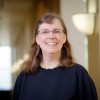This article is more than 5 years old.
This year’s meeting of the Southeast Music Library Association was hosted by our neighbors at Duke University. Lots of thought-provoking presentations!
DIGITAL HUMANITIES
A colleague at Duke who teaches both English literature and music appreciation noticed that her students often misidentify sounds — but that there was no dictionary to refer them to, as she does when her students misuse a word. So she decided to start up her own crowd-sourced Sonic Dictionary. Using an Omeka platform, it includes not only musical sounds, but ambient sounds in the environment, and soundscapes — anything that goes under the umbrella rubric “sound culture.” Contributors currently comprise students (at Duke and elsewhere) in music, anthropology, and other courses, but the general public is also encouraged to contribute (SEMLA attendees were turned loose on the Duke campus to collect new samples). Besides the fieldwork, students learn valuable lessons in the process of creating the metadata: for instance, many contributors think first of identifying the locale, but this is often less relevant to users of the dictionary than a precise description of what is going on in the sample (not as simple as one might think). In the Q&A, similar projects were mentioned, including the London Sound Survey, and libraries (such as the British Library) that have posted sound collections online.
A few years ago, the Library of Congress launched its National Jukebox — early popular music recordings in its collections. A couple more colleagues at Duke are currently building a NC Jukebox, based on the work of Frank Brown, a Duke scholar who did field recordings across the state in the early 20th century. The creators of the NC Jukebox introduced us to the concept of “music repatriation” — giving a copy of the field recording to the family or community of the (now often deceased) subject whose singing Brown captured. A recently-won CLIR grant will be used to conduct copyright research, which will hopefully result in downloadable files from a public website.
In a true reflection of where library discovery services are trending (and a lesson in “how to do it on a shoestring”), our neighbors the Moravian Music Foundation demonstrated how they converted their card catalog to an online one without owning a server or ILS. They developed a workflow based entirely on hosted services, including OCLC’s WorldShare Record Manager, Backstage (an outsourcer we use for our authority control), MarcEdit, MusCat (a cataloging editor developed by RISM, an online database of early music source materials), and for encoding musical incipits, Plaine & Easie Code and Verovio.
OUTREACH
A colleague at Elizabeth City State (NC) marketed her music collection by organizing “listening parties,” in which she and interested students viewed a DVD of a pop artist’s performance, using the music as a springboard for discussing social and political issues in a relaxed setting. She worked with her faculty, persuading some to give extra credit for attendance. The “parties” attracted growing numbers of students as the semester wore on, and she had faculty coming to her gushing about the elevated level of discussion happening in their classrooms as a result. She admits that the preparation is intensive and time-consuming — and you have to be the kind of person who is comfortable talking about often-sensitive issues. Still, an inspiring idea, and one that potentially could be applied with any artistic or creative work as the starting point.
COLLECTION DEVELOPMENT
A couple of years ago, a colleague at Kent State surveyed his music students on their preferences regarding library materials. This year, a colleague at Kennesaw State (GA) similarly surveyed her music faculty to determine (1) their priorities for purchasing, and (2) how frequently they used various materials. Both surveys revealed a preference for print books, print scores, streaming audio, and e-journals. Notable in faculty purchase priorities was the fact that there is not necessarily a neat correspondence between print and electronic versions of the same resource (print scores ranked first, but e-scores only third; p and e books were likewise separated in the rankings).
A panel session picked up a thread from the surveys, discussing factors that might explain low usage rates for e-scores: printing restrictions and short checkout periods (to learn to play a work, you need the whole score, and generally for the whole semester); copyright issues surrounding the performance of scores in online collections (mirroring similar issues with streaming audio and video databases); the nature of the music (the complexity of classical-music scores presents more challenges than for a jazz band performing from lead sheets, for example); and purpose (performance vs. analysis). Factors favoring e-scores revolve around equality of access — including for study abroad, and when your school offers online degrees.
SIDELIGHT
This year we had a truly rare treat when Duke’s concert series coincidentally scheduled, opposite our meeting, Schubert’s perennially haunting song cycle Winterreise (Winter Journey), performed by one of its leading interpreters, British tenor Ian Bostridge. Bostridge also spoke to our meeting about his latest book, Schubert’s Winter Journey: Anatomy of an Obsession, which won this year’s Cooper Prize for non-fiction. (ZSR recently acquired a copy.)

5 Comments on ‘Leslie at SEMLA 2016’
Leslie, thanks for this post! I just explored the NC Jukebox a bit and I love the Outreach idea of “listening parties”
Love all these inventive projects, and the collection development insights are useful as well! Thank you for sharing, Leslie, sounds like a great trip.
The Sonic Dictionary is inspired. What a great opportunity to fill a void.
Lots of cool stuff happening out that that I didn’t know about — thanks for sharing, Leslie!
The listening parties sound really cool. Thanks for sharing